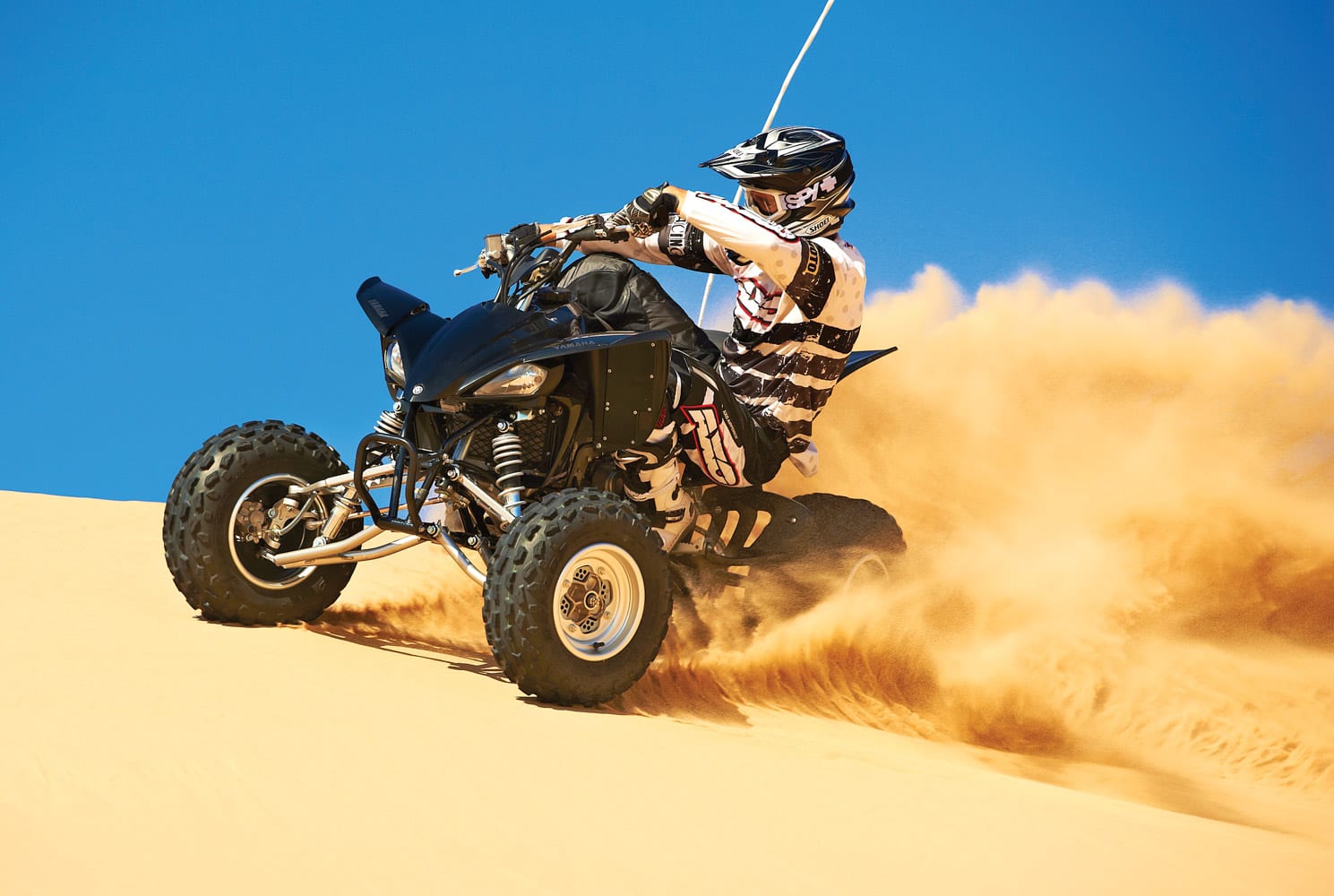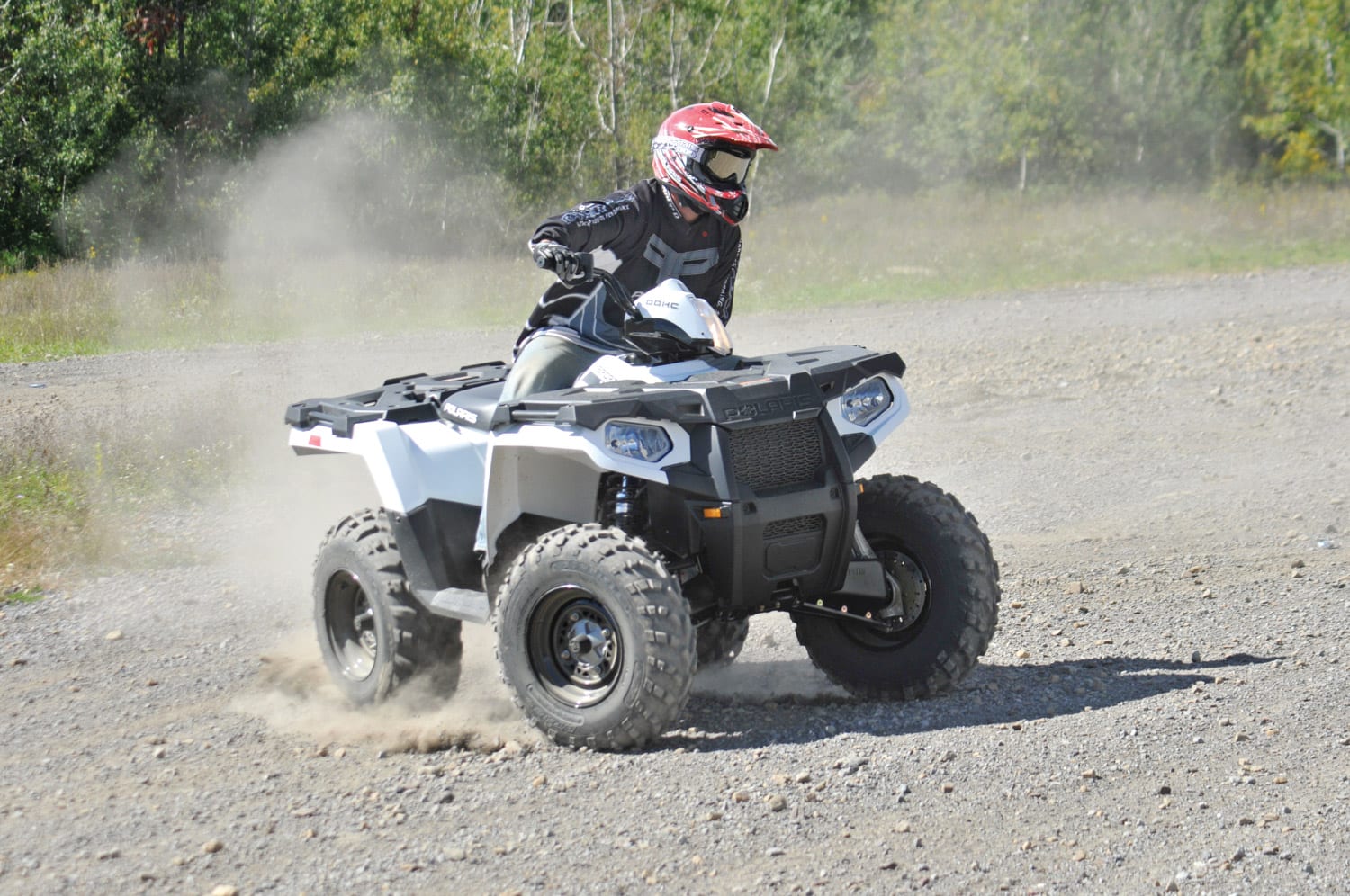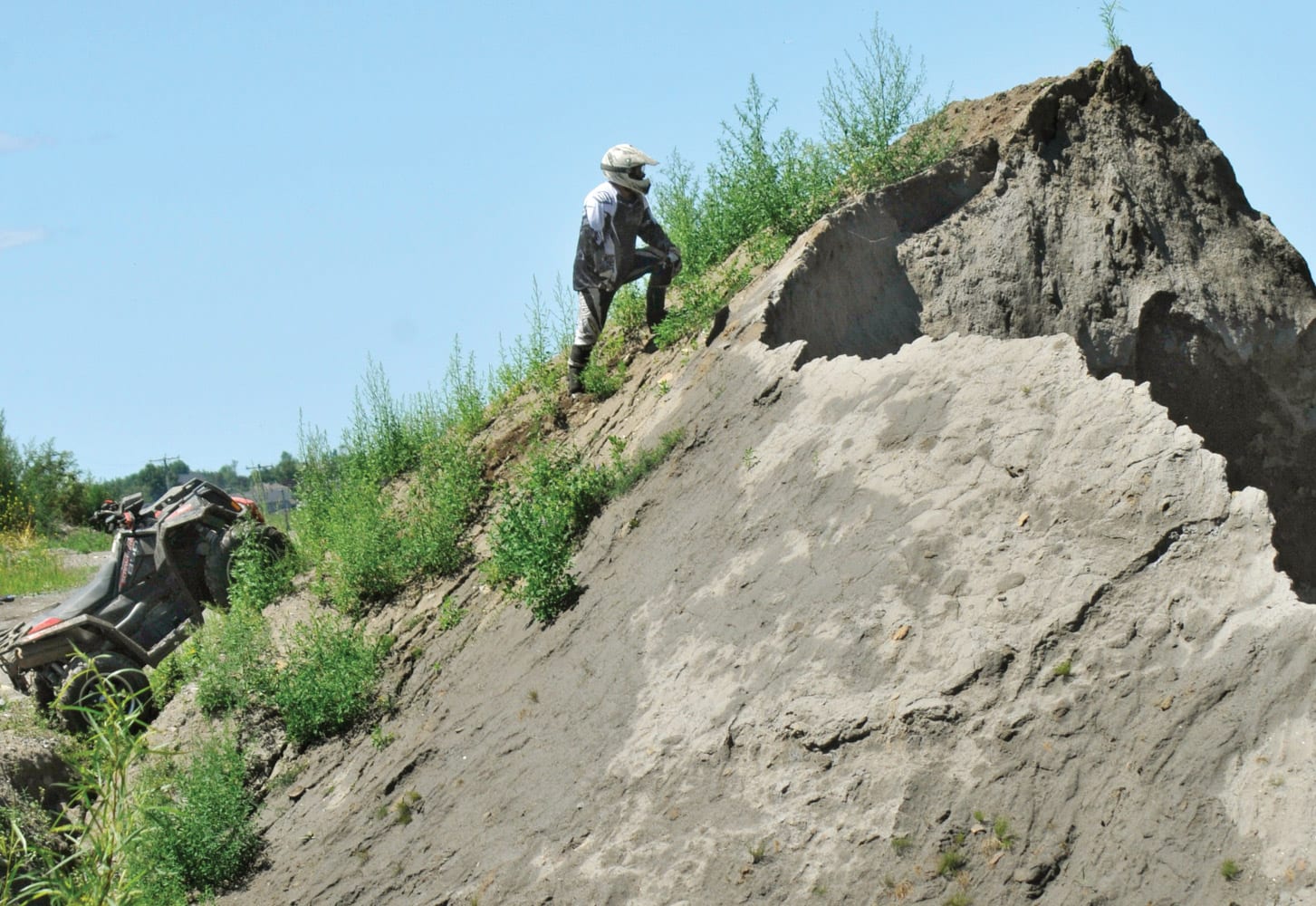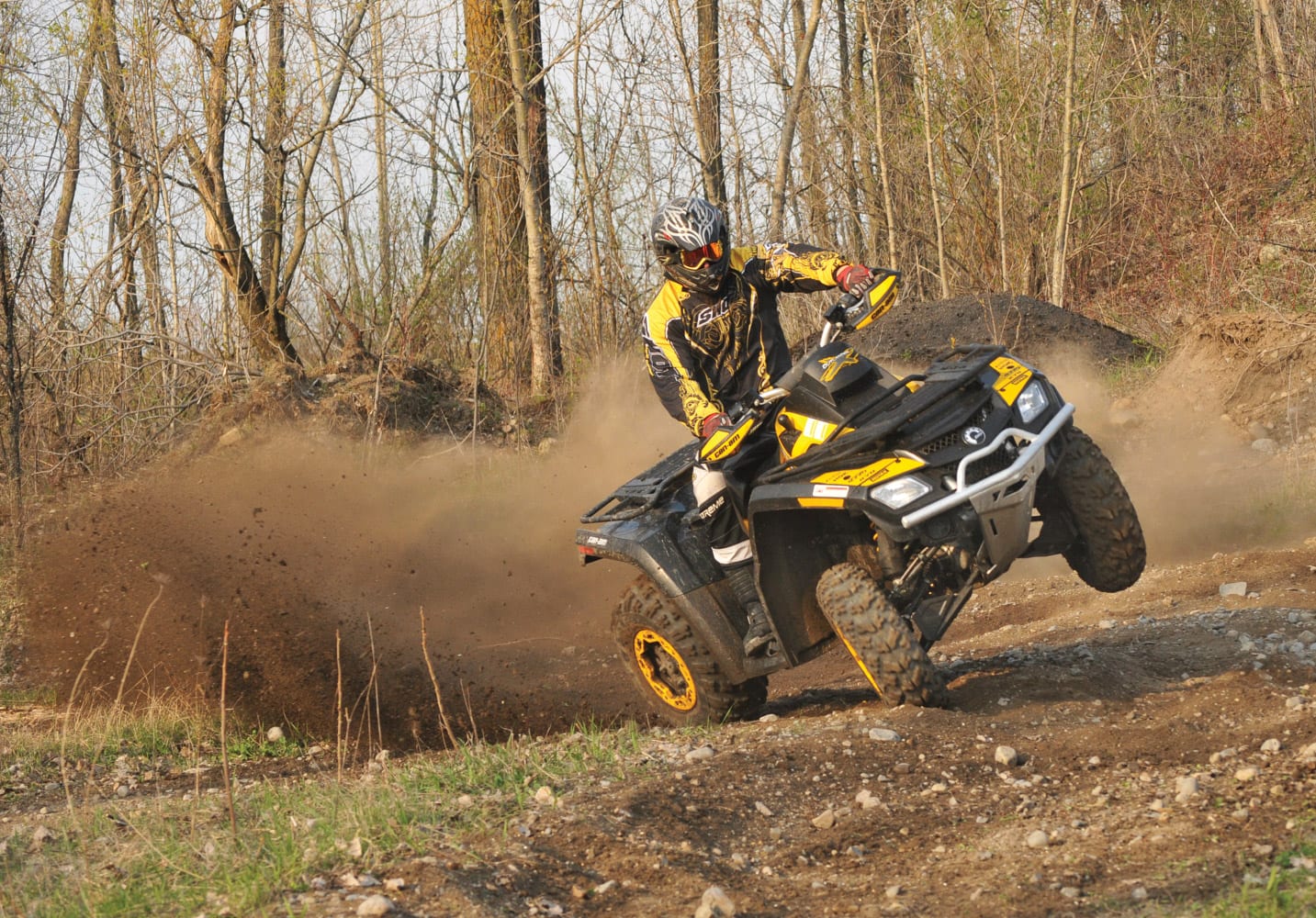What a beautiful thing to watch! The professional ATV racer punches over a first bump in a series of them aiming to slow his progression. Picture it: the shot is in super slow motion and with crystal clear detail, shot through high-quality lens under the control of the steadiest of hands. As the fascinatingly precise filming begins, the rider already has that elbows high and half-standing stance, the arms stretched forward as the rider approaches the rise, pushing the bum towards the rear keeping it just a few inches off the seat. The bump starts slowing the rider’s kinetic energy into the quads highly-advanced and precisely adjustable front shocks as the rider’s elbows and knees flex in tandem. The rider uses limbs as an added suspension, letting the body move forward and the rear seems to just gracefully follow through and as the front shocks start pumping back out and the front of the quad reaches the top. The shot starts displaying a more spectacular side of the rider’s perfect symbiosis with the ATV, as the rear wheels leave the ground with just enough rebound to pop the quad up to a nicely-levelled flying position at the same time, as the rider is propelled back up standing with stretched limbs. Just for style, the rider decides to flex only the right side knee and elbow, causing the quad to tilt during flight. From one fraction of a second to the next the rear wheels freeze up. The rider has just applied the rear brake to help get the front back down to land perfectly into the landing, so to optimize momentum going into the next ramp up. What an amazing display of skill and experience! One all level of riders should be inspired by, but that should not be attempted before having gone through all the other learning steps. Such a scene represents the very last step in a slow progression. Don’t try and skip any steps on your quest for ATV riding excellence, or it could make it a very short-lived experience.

We are still going to recap on a few things, just to make sure everyone doesn’t skip any steps in this slow but fun to experience progression to ATV trail riding readiness, or maybe even right up to professional ATV racing for some of you, who knows? The notion of preventive riding is the main thing we tried to describe, explain and encourage in lesson #1. The importance of a rider’s initial position, of body placement and movement while conquering turns or obstacles, or both combined, was described in detail, as only part of this philosophy, which combines with other factors such as the proper way to prepare and dress for the occasion and keeping the vehicle in top shape, always with the same ultimate goal: to minimize risk as much as possible.
Before you can start doing what is about to be described in this lesson, it is imperative you have totally understood and mastered body placement and movement techniques mentioned in the first.
PRE-TRAIL RIDING PRACTICE
Every rider, at one point or another, will encounter foul weather, unexpected obstacles, uneven terrain or other hazards. It is imperative that you learn and practice basic riding techniques before challenging yourself in unpredictable trails. Before heading out onto designated trails, take some time to get used to your ATV and your safety equipment. Get familiar with how your vehicle operates, as well as its limitations. Some ATVs have the ability to switch from 2- to 4-wheel drive. Switching into 4-wheel drive greatly affects how the vehicle handles, especially its turning ratio and ability to swerve. Familiarise yourself with your ride’s 4WD system and the way it affects its handling before heading out onto trails.

It is natural to want to challenge one’s self to try and develop new skills. However, in tight winding trails it’s never a good idea. Developing skills as an ATV rider isn’t done in a day either, patience is a beginner’s most precious weapon and any sort of exploration into advanced manoeuvres should be done in a controlled practice setting, and under the supervision of an experienced rider who has the proper skill set to teach the less experienced rider.
Riding Circles & figure eights on a nicely-groomed surface with grass no higher than two or three inches, without any obstacles for now, and cleared up of any potentially dangerous trinkets like glass bottles or pointy rocks lying around, is the ideal and only way to gain confidence, while perfecting the all-important weight transfer technique. Test the ATV’s turning ratio, its acceleration and response to input on the throttle, and the brake’s response at different speeds. When braking with your ATV, always use both front and rear brakes to better control your movement, especially when traveling at higher speeds or before cornering. Using only the front will create too much front end dip and will need more weight transfer towards the back. Using only the rear brakes will provide very little stopping power and can make it much more difficult to control your vehicle, as the rear wheels will easily lock up and send the ATV into a slide. In certain situations where braking distance ends up insufficient, releasing them might be necessary to regain traction and control. Practicing obstacle avoidance under braking is one of the most important things to do right now, in your controlled setting under supervision. It is always better to brake with the rear first (only a fraction of a second earlier) and then add just enough pressure at the hand-controlled front brake, to efficiently slow down without locking up the wheels. In some cases it can be better to lock up only the rear for an instant and then release it simply to change trajectory and avoid an obstacle to one side when braking distance is judged insufficient. It’s important to use the same weight transfer as usual; if you want the rear to slide out to the left, in preparation to avoid towards the right side, you need to transfer weight to the right. Try not to panic and apply the brakes in a smooth controlled motion. When you feel the tires start to slide, release pressure on the controls ever so slightly, to try and keep them from locking.
First-time riders should start in a low gear. Some of these vehicles have a lot of torque, so apply the throttle slowly and keep your feet firmly on the footrests. Remember what was said in lesson 1 about initial seating position? Don’t sit too far back on the seat! Ok now you’re ready to add a few obstacles to your practice area. Drop a 4 to 5 inch log on the ground and try to slowly roll over it at a 90 degree angle first and then keep trying with different angles and eventually also try skipping over the ends with just one side of the ATV, adding weight on the same side as the obstacle.
Properly operating an ATV needs a rider-active approach. A rider’s position on the vehicle will greatly affect how the vehicle operates. For these reasons and others, operating an ATV while under the influence of drugs or alcohol is not only against the law but distorts a person’s perceptual skills, attention span, judgment, vision, balance and reaction times, which all lead to dangerous conditions when operating any motorized vehicle!

HITTING THE TRAILS
As a responsible and safe ATV rider, you must always recognize your personal limits and ride within those limits. More often than not, you will be riding in a group, or at least with one or two friends, which is all fine and even strongly recommended, but it is imperative that the influence factor be recognized and controlled. Most of the time inexperienced operators will feel pressured to follow the group. Ideally each member of the group should take the other riders’ skill level into consideration when choosing their pace. Using more advanced maneuvers and riding too fast in front of a newbie can pressure that person to perform more than their skill level permits. Each person is responsible for the other’s whereabouts and well-being, and must be ready to assist in case of emergency.
If you are riding in a group with less experienced operators, be sure to operate within the limits and experience level of those operators to ensure you are not putting their safety at risk. If you are the less experienced operator within a group, don’t be afraid of letting the other riders know of your limitations, and ask them to ride within those limits. Most importantly, know your own limits and ride within them!
There will be times when you will be tempted to challenge yourself when out on the ATV trail and attempt more advanced maneuvers. However, this often leads to dangerous situations. It is fine to want to fully explore the capabilities of your ATV, even recommended by our editor, who even encourages beginning riders to practice trick maneuvers at very low speeds, but you are supposed to do that before going out on shared trails. You’ll need to turn around and get back on flat open grounds under the supervision of an expert, to get a true understanding of how an ATV can be kept under control, BEFORE you go zipping by trees. As a matter of fact, every rider upgrading to a more powerful new ride, maybe bigger and heavier, should do the same and practice some circles, figure eights and braking in good company in more open places.
It is very important to respect trail access at all times. Wherever you are riding, treat the land with the utmost respect. ATV riders that rip around fields or on closed trails leave trash behind or endanger others that use the land, have an exponentially negative impact on our entire community, so please don’t hesitate to interfere and try to educate them with a civilized approach.Reckless behavior gives a bad impression of ATV operators to other people, including land owners and law enforcement officials. Reckless action can also contribute to environmental damage and trail closings, which eventually mean: fewer places for us to ride.

Here is a set of rules to go by when riding out on any trail:
- Act in a responsible, safe manner and respect others and the environment.
- Promote a positive view of all ATV riders and the ATV community.
- Avoid riding over vegetation wherever possible.
- Never pull over in a turn or on top of a hill.
- Always pull over to the right side of the trail if possible.
- Turn off your engine and remove your helmet when you pull over to hear other vehicles.
- Avoid rider fatigue; take a break every 30 minutes or so (always carry water with you).
- If you come across hikers or people on horseback, pull over, turn off your engine, dismount the ATV and remove your helmet.
- Always ask the landowner’s permission before riding on private trails.
- Yield to other riders who wish to pass you.
- Avoid riding close to campgrounds, residential areas, or anywhere engine noise can be a nuisance.
- Operate at low speeds when you are around crowds.
- When going downhill, yield to riders that are climbing the hill.
- Do not jeopardize your safety and the safety of others by operating an ATV in an altered or impaired state.
- As a general rule of thumb, you should remain at least 3 seconds behind the rider in front of you (increase to 5 or even 7 seconds in bad weather).
YOUNG OPERATORS
Young operators must always be under direct adult supervision when riding an ATV. Furthermore, it is every parent’s responsibility to ensure that their child has adequate training to handle the ATV properly and safely. When instructing a young operator on riding safety, it is crucial they realize that ATVs are not toys, and can cause serious harm if they are not handled properly. Almost all serious injuries are caused by the fact that the ATV is too big for him or her. To avoid serious injury, it is very important that parents or guardians limit the child to an ATV that is of the correct size and horsepower.
Young operators must have the capability to control the vehicle they are operating. In many accidents involving children, the child was operating a vehicle that was too large to handle properly. It is equally important to ensure that children are not too big for the vehicle they are operating. If the child is too big for the ATV, their knees will interfere with steering and the ability to change riding positions. Maturity or common sense are required to operate a motorized vehicle and so parents and guardians should check a few factors before letting the young rider ride off into the distance on an ATV. The operator needs to have good depth perception, peripheral vision, and hand-eye coordination. An adequate attention span and the ability to handle perceptual challenges are also necessary.
If an ATV is designed to accommodate a passenger (or not), adults might be tempted to take children out for a ride. However, children can be at great risk of injury even if they are merely a passenger on an ATV. Before allowing a child on as a passenger, please ensure they can reach the passenger footrests, can properly hang onto the passenger handles, and understand the importance of safe behavior as a passenger. Of course passengers should wear all safety gear while riding. With a passenger, the operator must keep a much slower pace and realize how the extra weight can greatly affect the handling of the machine. Only experienced riders should operate an ATV with a passenger.
Safety is THE most important factor and at the source of our desire to educate as many, as much as possible, on proper use of all and any off-road trail vehicles. The future of this enriching activity that is wilderness exploration, so many people enjoy, depends on it!






